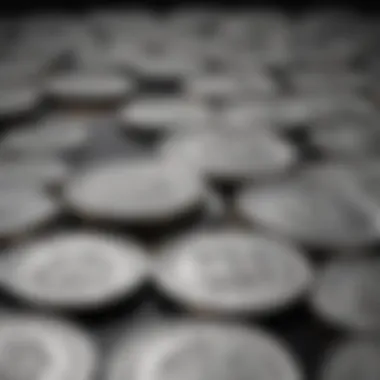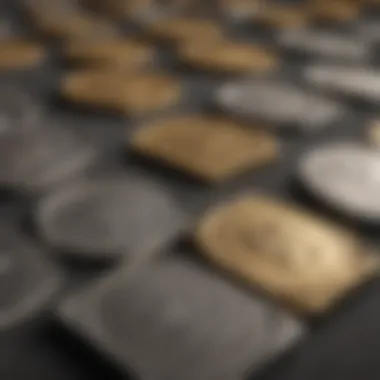Understanding Spot Prices for Gold and Silver


Intro
Spot prices of gold and silver represent the current market price at which these metals can be purchased or sold for immediate delivery. Understanding these prices is crucial for investors and enthusiasts in the financial sector. Spot prices fluctuate frequently, influenced by various factors such as market demand, geopolitical events, and economic indicators. It is essential to gain insight not only into what drives these prices but also into their wider significance in the investment landscape.
Analyzing gold and silver spot prices offers a glimpse into broader economic trends. These precious metals, being tangible assets, often serve as a hedge against inflation and currency fluctuations. Therefore, grasping their spot prices can aid investors in making informed decisions about asset allocation and risk management. This article aims to explore the definitions, significance, and factors that cause fluctuations in the spot prices of gold and silver, creating a foundation for deeper financial understanding.
Prelude to Spot Prices
Spot prices play a crucial role in the trading of precious metals like gold and silver. These prices are the current market prices at which these metals can be bought or sold for immediate delivery. Understanding spot prices is essential for both novice and seasoned investors. It influences their investment strategies and decisions in the commodities market. The significance of spot prices goes beyond mere numbers; they reflect supply and demand dynamics, investor sentiment, and the overall health of the economy.
In this article, we will focus on several key elements that make spot prices a vital topic in the financial world. First, we will define what spot prices are and explain why they matter. Then, we will explore market dynamics that affect these prices. Potential investors and financial enthusiasts must grasp these concepts to navigate the often-complex environment of gold and silver trading effectively.
Understanding spot prices can provide insights into the best times to buy or sell metals. Additionally, they allow investors to make informed decisions based on current market conditions. Spot prices impact trading strategies directly and indirectly, shaping both short-term trades and long-term investment plans. It is crucial to comprehend the fluctuations and influences on these prices as they occur in real time.
Spot prices are essentially the lifeblood of the precious metals market, dictating trading strategies and investment outcomes.
This section serves as a gateway into the detailed analysis of spot prices for gold and silver. It sets the tone for the subsequent discussions that will dissect trends, historical data, and various factors that influence these prices. With that foundation laid, we will now delve into the specific definition of spot price.
Spot Prices of Gold
The examination of spot prices for gold is vital in understanding the broader financial landscape. Spot prices serve as the foundation for gold trading and investment. They reflect the current market rate, which changes based on various factors including demand, economic indicators, and geopolitical variables. Knowing the spot price can help investors make informed decisions related to buying and selling gold.
Gold holds a significant position, not just as a commodity but also as a safe-haven investment. Many investors turn to gold during times of economic uncertainty, which directly influences its spot prices. Thus, recognizing the current trends in gold spot prices can yield insights into market sentiment and investor behavior.
Current trends often indicate the health of the global economy. An increase in spot prices might suggest heightened demand or reduced supply while decreasing prices can imply the opposite. For investors, these cues are critical for strategizing their portfolios and understanding potential future movements in the market.
Current Spot Price Trends
Spot price trends for gold fluctuate frequently. Recently, gold has shown an upward trend, driven mainly by inflation concerns and a weakening US dollar. Investors are increasingly turning to gold as a hedge against inflation, causing spot prices to rise. Various factors, including central bank policies and interest rates, also play a crucial role in shaping these trends.
Data from sources like Reuters and Kitco offer real-time updates on gold prices. Regular monitoring of these trends is essential for anyone looking to invest.
Historical Analysis of Gold Spot Prices
A historical analysis of gold spot prices reveals patterns that can inform future investment decisions. For instance, during the financial crisis of 2008, gold prices soared as investors fled to safety. The price of gold in 2008 was around $800 per ounce, which steadily increased, reflecting increased demand and market volatility.
Examining gold prices over the last few decades, it is clear that they often respond to global economic events. Significant spikes occurred during geopolitical tensions and financial upheavals, indicating a strong inverse relationship between gold prices and market stability.
Comparative Analysis with Historical Data
Comparing current gold spot prices with historical data provides valuable context. For example, the price of gold is significantly higher than it was in the early 2000s, where it hovered around $300 to $400 per ounce. This dramatic increase is indicative of global trends, such as increasing wealth, higher demand for gold in technology, and more people investing in gold as a hedge.
Recent prices can be plotted against key historical events. This visual understanding helps investors grasp how global dynamics affect gold spot prices over time. Monitoring these fluctuations is important for formulating investment strategies and understanding economic health.
Important Note: Observing historical trends does not guarantee future performance, but it does provide insights into how spot prices may react to similar situations in the future.
Spot Prices of Silver
The topic of spot prices for silver holds significant importance, particularly for those interested in investing and trading precious metals. Silver, often seen as a counterpart to gold, serves various purposes including industrial applications, investment, and jewelry. Understanding spot prices provides insight not only into the current market value but also into broader economic conditions that affect the demand and supply of the metal.
Spot prices reflect the immediate trading value of silver in the market. Investors and traders closely monitor these prices as they can indicate market sentiment and future trends. Moreover, knowing the spot price aids in making informed decisions in buying or selling silver. As the market can be volatile, grasping the nuances behind these fluctuations can translate into enhanced investment strategies.


Current Spot Price Trends
Currently, the spot price of silver is influenced by multiple factors, including global economic health, geopolitical tensions, and changes in supply chains. Recently, there has been a notable increase in demand for silver in electronic manufacturing and renewable energy sectors. This industrial demand competes with investment demand, where investors flock to silver as a hedge against inflation and currency devaluation. Traders often utilize technical analysis to identify potential entry or exit points in the market, providing a crystal ball of sorts for what might come next.
Statistical reports reveal that silver's spot prices can show sharp reactions to financial news, making it crucial for investors to remain updated. For example, when major financial institutions adjust interest rates, the price of silver may reflect those changes within days or even hours. Keeping an eye on these economic indicators can provide insight into potential spot price movements.
Historical Analysis of Silver Spot Prices
Understanding the historical context of silver spot prices adds depth to any investment strategy. Over the past few decades, silver prices have experienced significant fluctuations. From all-time highs in the early 1980s to drops in the late 1990s, and more recently during economic crises, the price of silver paints a complex picture of market behavior.
Many investors refer to the patterns observed in various economic cycles. For instance, periods of economic uncertainty tend to correlate with rising silver prices as investors seek safe-haven assets. Similarly, during growth periods, the demand for silver in manufacturing pushes prices in a different direction. Analyzing these trends can help investors position themselves advantageously in the market.
Comparative Analysis with Historical Data
When examining the current spot prices of silver, it can be enlightening to compare them with historical data. This comparative analysis allows investors to draw connections between past movements and present conditions. Historical spot prices can serve as benchmarks.
In comparison with historical peaks and troughs, recent prices reveal either an overvaluation or undervaluation. For example, if current prices surge past previous highs without accompanying demand metrics, it may indicate a bubble. Conversely, if prices remain low during high demand periods, this could suggest a buying opportunity.
"Investors should always consider the historical context when analyzing current spot prices to avoid emerging market hype."
Within this comparative framework, one can also assess how silver's performance stands against gold. Historical trends often reveal moments where silver follows the gold market closely, diverging at times based on specific economic catalysts.
In summary, the study of silver spot prices encompasses a range of considerations. Understanding current trends, alongside historical analysis and comparative evaluations, can significantly enhance one’s investment acumen. By remaining vigilant and informed, investors can navigate the complex landscape of precious metals.
Factors Influencing Spot Prices
Understanding the factors that influence spot prices is critical for investors and financial enthusiasts alike. Spot prices for gold and silver do not exist in isolation; they are deeply affected by various elements ranging from market dynamics to economic conditions and global events. Awareness of these influences can help investors make informed decisions and strategize effectively in their trading endeavors.
Demand and Supply Dynamics
The interplay of demand and supply is fundamental in determining the spot prices of precious metals. When demand for gold or silver rises—for instance, due to increased interest in physical bullion or jewelry—prices tend to climb. Conversely, if supply significantly exceeds demand, a decrease in prices may follow.
Several factors can impact demand:
- Jewelry Demand: A significant portion of gold and silver demand stems from the jewelry industry. Changes in fashion trends, economic conditions in producing countries, and cultural events can impact this sector.
- Investment Demand: Interest in gold and silver as safe-haven assets can drive prices up during economic uncertainty. Investors often flock to these metals in times of market instability.
- Industrial Demand: Silver, particularly, has substantial industrial use in electronics and renewable energy technologies. Economic growth can spur industrial demand, thereby influencing spot prices.
Supply factors also play a critical role. Mining yields, recycling rates, and geopolitical issues can all affect how much gold and silver is available in the market. A reduction in supply can lead to heightened prices, while overproduction may do the opposite.
Economic Indicators and Their Impact
Economic indicators significantly shape the market for gold and silver. These can include interest rates, inflation rates, and currency strength. For example, lower interest rates often make precious metals more attractive since the opportunity cost of not holding interest-bearing assets becomes more pronounced.
- Inflation: Rising inflation typically weakens currency values, driving investors to seek refuge in gold and silver. As inflation expectations rise, demand tends to increase and subsequently elevates spot prices.
- Currency Strength: The strength of the U.S. dollar inversely affects precious metal prices. A weak dollar tends to bolster demand for gold and silver, pushing their prices higher, while a strong dollar can have the opposite effect.
Monitoring these economic indicators allows investors to predict potential shifts in spot prices and adjust their strategies accordingly.
Global Events Affecting Spot Prices
Global events can dramatically influence spot prices. These events might range from political instability, natural disasters to global pandemics.
- Geopolitical Tensions: Conflicts or tensions in key gold and silver producing regions can disrupt supply chains, leading to price surges. Events such as trade wars or sanctions can also have long-lasting effects on metal markets.
- Financial Crises: Market crashes, like the one in 2008, often lead to an increased demand for gold as a secure store of value. The initial panic can drive prices sharply upward, as more investors flock to precious metals for stability.
- Natural Disasters: Situations that damage mining infrastructure or impact global supply chains can temporarily tighten supply, affecting spot prices.


In summary, the price of gold and silver is sensitive to a multitude of factors. By understanding these influences, investors can position themselves more effectively in the market and mitigate risks associated with price fluctuations.
The Significance of Spot Prices in Trading
The understanding of spot prices is crucial for anyone involved in trading gold and silver. Spot prices reflect the current market value of these metals and provide a baseline for transactions. They are not static; they fluctuate regularly based on market conditions, demand, supply, and other macroeconomic factors. Understanding these nuances gives investors an edge in their trading decisions.
Spot Prices versus Futures Prices
Spot prices differ significantly from futures prices, which are contracts to buy or sell assets at a predetermined price at a specified time in the future. Spot prices are determined by immediate supply and demand in the market. This makes them vital for real-time trading strategies. Investors using spot prices can make quicker decisions, reacting to changes in the market as they happen.
Key Differences:
- Timing: Spot prices require immediate execution, while futures prices deal with an agreement for a later date.
- Market Influence: Spot prices are influenced by current market trends, whereas futures prices can be affected by projections about future demand and geopolitical events.
This distinction affects strategies that traders may choose. For instance, a trader focused on short-term gains may prefer using spot prices, while others may look into futures for balancing portfolios or hedge risks.
Investment Strategies Based on Spot Prices
Using spot prices effectively can form the backbone of various investment strategies.
- Short-Term Trading: Traders focusing on spot prices often engage in techniques like day trading, where they buy and sell based on the fluctuations throughout the day.
- Buy-and-Hold Strategy: Some investors might buy at current spot prices intending to hold until future price increases, leveraging the volatility of precious metals.
- Arbitrage Opportunities: Spot prices can also reveal discrepancies between different markets, allowing savvy investors to engage in arbitrage, buying in one market and selling in another at a profit.
By understanding how spot prices function, investors can develop informed strategies that align with their financial goals.
Hedging with Spot Prices
Hedging is a risk management strategy that involves making investments to offset potential losses. Investors can use spot prices to hedge against various market movements.
- Protect Against Declines: If an investor holds physical gold or silver, they can use spot prices to sell at opportune moments, thus locking in profits or minimizing potential losses.
- Financial Instruments: Many investors utilize financial instruments like options and ETFs that track spot prices. This creates flexibility in adjusting their positions without holding the physical asset.
For many, spot prices function as an essential indicator for making these informed decisions, ultimately allowing investors to navigate the complexities of the market with greater confidence.
Spot Price Comparisons
Comparing the spot prices of gold and silver is crucial for investors and market analysts. Understanding the dynamics behind their price movements provides insights into broader market trends and economic indicators. This section examines key factors that aid in the comparisons, the benefits of such analyses, and considerations for investing.
Gold versus Silver Spot Prices
Gold and silver have distinct roles in the investment market. Gold is often viewed as a safe-haven asset, especially in times of economic uncertainty. Its price generally tends to be more stable compared to silver, which is more volatile. Silver’s price reflects industrial demand, which can lead to rapid fluctuations.
Key Points of Comparison:
- Market Demand: The demand for gold is primarily driven by investment and jewelry needs. In contrast, silver has a significant portion of its demand stemming from industrial uses, such as electronics and solar energy products.
- Market Sentiment: Investor sentiment can impact spot prices. Market conditions favoring risk aversion often bolster gold prices, while silver can be more susceptible to speculative trading.
- Economic Conditions: In a robust economy, silver prices may rise due to increased industrial activity. However, gold typically benefits during economic downturns when investors seek stability.
Analyzing the spot prices relative to each other can assist investors in making informed decisions about where to allocate their resources. For instance, when gold is outperforming silver, it may signal a shift towards risk aversion in the market. Conversely, an increase in silver prices relative to gold could indicate rising industrial demand or inflation expectations.
Volatility in Metal Prices
Price volatility is an intrinsic characteristic of gold and silver. Understanding this volatility is essential for investors looking to navigate the precious metals market. Factors affecting these fluctuations include economic indicators, geopolitical tensions, and market speculation.
- Geopolitical Events: Wars, elections, and trade disputes can lead to sudden changes in spot prices. For instance, during geopolitical tensions, investors often flock to gold, creating upward pressure on its price.
- Central Bank Policies: Actions taken by central banks regarding interest rates can also influence metal prices. Low interest rates generally make gold more attractive as a non-yielding asset.
- Currency Fluctuations: The strength of the US dollar plays a pivotal role in the pricing of gold and silver. A weaker dollar can lead to higher metal prices as they become cheaper for holders of foreign currency.


In summary, comparing gold and silver spot prices provides valuable insights for investors and analysts. The distinct characteristics and behaviors each metal display can guide investment strategies. Recognizing the volatility tied to these assets aids in risk management and potential profit realization.
Investment Considerations
In the realm of precious metals investing, understanding the nuances of gold and silver spot prices holds substantial significance. This section aims to provide a framework for investors, whether they are seasoned or merely starting their investment journey. The investment considerations regarding gold and silver go beyond mere price observations. They encompass strategic maneuvers that guide decision-making processes within market dynamics.
Deciding Between Gold and Silver
When considering an investment in precious metals, the choice between gold and silver is pivotal. Each metal possesses distinct characteristics that appeal to various investor profiles.
Gold often serves as a safe haven asset. Its value remains relatively stable during economic turmoil. Investors usually gravitate toward gold to hedge against inflation and currency fluctuations. This metal has a long history of being recognized as a store of value, further solidifying its status in investment portfolios.
On the other hand, silver offers a different appeal. Its industrial applications can enhance demand, affecting spot prices. For instance, silver will see higher demand in sectors like electronics and solar energy. This correlation between industrial use and investment demand can create opportunities for profit. Therefore, investors who wish to capitalize on market cycles often consider silver as a more dynamic investment option.
Ultimately, the decision hinges on individual risk tolerance and investment goals. Investing in gold might represent stability, while silver might present higher potential for returns at increased risk.
Portfolio Diversification with Precious Metals
Portfolio diversification is crucial in managing investment risk, and precious metals play a vital role in this strategy. By incorporating both gold and silver, investors can balance the volatility of various asset classes.
- Risk Mitigation: Precious metals often exhibit unique performance patterns against stocks and bonds. When equity markets decline, metal prices can perform well. This inverse relationship can help cushion overall portfolio downturns.
- Inflation Hedge: Gold and silver are tangible assets, so they tend to retain worth during inflationary periods. When fiat currencies devalue, metals often appreciate, providing a safeguard against erosion of purchasing power.
- Opportunity for Growth: While gold remains a stable investment, silver's price may fluctuate more prominently. This can lead to potential growth opportunities when timing the market correctly. By holding both assets, investors can enjoy the stability of gold while exploring the highs of silver’s demand in various industries.
The Future of Gold and Silver Spot Prices
The future of gold and silver spot prices holds significant importance for investors, traders, and financial enthusiasts. These prices shape market strategies and investment decisions. As we navigate through economic uncertainty, understanding the anticipated shifts in these spot prices can provide valuable insights. Spot prices offer a real-time reflection of market conditions, and their predictions may influence buying or selling strategies among investors. In this section, we will explore key considerations related to the future of these precious metal prices.
Predictive Analysis of Market Trends
Predicting the market trends for gold and silver spot prices involves analyzing various factors that impact supply and demand. Market dynamics can shift based on global economic conditions, geopolitical tensions, and fiscal policies.
Several elements contribute to prediction models:
- Economic Indicators: Inflation rates, currency value fluctuations, and interest rates can significantly affect the demand for gold and silver. Rising inflation often drives investors toward these metals as safe havens.
- Market Sentiment: Investor psychology plays a crucial role. For instance, fear in the market can lead to increased demand for physical gold and silver.
- Technological Advancements: Innovations in extraction and production methods can affect the supply side, influencing prices.
- Geopolitical Events: Tensions or instability in key regions affect investor confidence and can result in price volatility.
To illustrate, analysis shows correlations between currency depreciation and sharp increases in gold prices. These patterns can serve as indicators for future trends. Understanding these predictors helps investors formulate informed strategies.
"Spot prices of precious metals are often viewed as barometers of economic health. Carefully tracking these indicators can lead to more effective investment decisions."
Investors might consider utilizing various analytical tools. These include software that tracks financial indicators, as well as reports from trusted financial news outlets. Continuous research is crucial to stay updated.
In summation, the future of gold and silver prices is influenced by a multitude of factors, and predictive analysis can guide investment choices in an ever-changing market.
Finale
The conclusion of this article emphasizes the significance of understanding spot prices for gold and silver, which are critical in the realm of precious metals. Spot prices serve as the immediate valuation of these metals, influencing countless transactions in both commercial and investment contexts.
From the beginning, we have explored how spot prices are not merely numbers but reflect deeper market dynamics. Investors must recognize that these prices change based on various factors including demand, supply, and external economic indicators. With this understanding, investors can make informed decisions aligned with current market conditions.
Benefits of Grasping Spot Prices:
- Real-time Awareness: Knowing the spot prices allows for timely investments or sales.
- Market Positioning: Investors can position themselves advantageously against market fluctuations.
- Diversification Strategies: A robust grasp on these prices aids in enhancing portfolio diversity by including both gold and silver.
It is essential to consider that the future of spot prices will continue to evolve, influenced by global economic shifts. Therefore, an ongoing assessment of trends and predictions is crucial. The past and present should be examined to anticipate future movements, allowing for proactive investment strategies.
"Understanding the nuances of spot prices is not just a financial necessity but a strategic advantage in the investment landscape."
Ultimately, the insights gained about spot prices culminate in a more thorough preparedness for engaging with the market. By integrating the knowledge from this article, both budding and seasoned investors enhance their ability to navigate the complexities of gold and silver investments effectively. The journey from understanding to application can ultimately influence decision-making, leading to more significant investment success.



